Some of my favorites from shooting timelapse in 2012. These were all frames from a timelapse. The timelapse will be out this winter.
Click on Photos to Enlarge
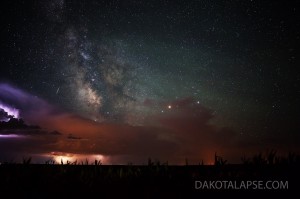
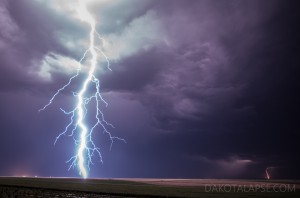


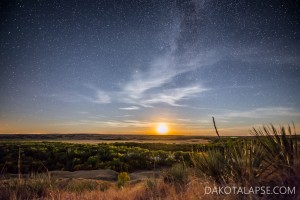

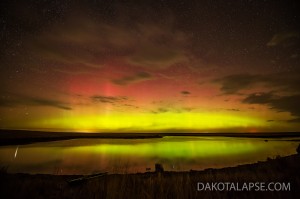
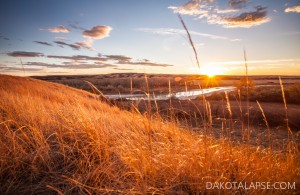
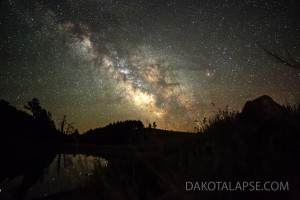

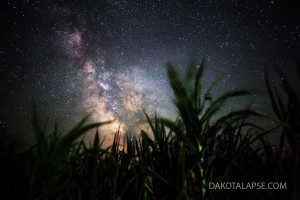
Some of my favorites from shooting timelapse in 2012. These were all frames from a timelapse. The timelapse will be out this winter.
Click on Photos to Enlarge











Update: Phil Plait also wrote this article about it.
What are the odds that you can catch a meteor with a persistent train, in the same spot, one year later? On October 6th, 2012, I setup timelapse, in the location that I caught this one.
2011 Meteor with persistent train – click to enlarge
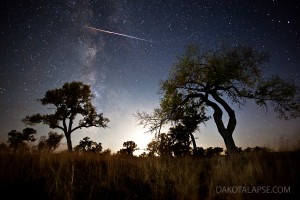
I had not shot any timelapse at that spot, since October 2011. At 10:07 PM the camera caught a meteor, the following 40 frames show the persistent train drifting off to the east, then it disappears. It lasted over 20 minutes in real time. I don’t think it would have been visible to the naked eye, but with 30 second exposures, it is. Taken in central South Dakota with a Canon 5D Mark III, Nikon 14-24 with novoflex adapter, F2.8, 30 seconds, ISO 3200
Phil Plait wrote about meteor persistent trains, with my photos from last year, here.
The Meteor – click photo to enlarge

2 minutes 10 seconds later – close up of persistent train – click to enlarge
Meteor from 2nd Camera, a few hundred yards away – 5D Mark II with Canon 16-24
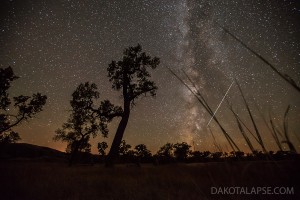
The other night, I shot a timelapse of the Moon, Venus and Jupiter conjunction west of Madison, WI. It was about 20 degrees, so not real cold, but cold enough to need some cold weather gear on the camera. The above video shows the short timelapse, and also a behind the scenes timelapse. It is a crescent moon, but I was shooting 20 second exposures, so it looks full. A Storm Jacket by Vortex Media is on the 5D Mark II, on the Dynamic Perception Stage Zero Dolly.
I get a lot of questions like, “How do I keep Dew or Frost from building up on the lens?”, in cold, or just damp nights from humidity. Every night I shoot, whether I think I need it or not, I use disposable hand warmers on the lens. I place it on the bottom of the lens and hold it on with a rubber band. You could also use anything else that would work to hold it on, like a velcro strap, tape, etc. The temperature of the lens only needs to be a little warmer than the outside temp to keep it dew and frost free. I used them when I shot Sub Zero, in -25 F wind chill. This works most of the time. But if the humidity is extremely high, it may not keep up on a real wide angle lens with a large front element, like the Nikon 14-24. But I’m not sure if a battery operated one would work any better. They sell battery operated lens warmers, but I don’t want to deal with any more wires and batteries than I already have. You can also buy a lot of hand warmers cheaper than buying one battery operated lens warmer.
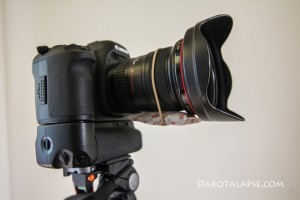
My timelapse setups usually run for 3-4 hours, and most of the time I’m not immediately near it. It’s best to set it up and leave it alone. That way stray light from a flashlight, doesn’t ruin the shot. I have been looking for a replacement for the cheap rain covers that I have used in the past. I found one that I think will work better than others I have looked at. It is the Storm Jacket by Vortex Media. The Storm Jacket is compact when folded up and has a bungee closure at each end. See more info about it on their site.
The Storm Jacket Pro Model, which I have, also has a large velcro opening on the bottom. That way you can use it with a tripod, or on a dolly. I’ve used it on the Dynamic Perception Stage Zero dolly and it worked great. The Storm Jacket is well made and will keep dew, rain, snow and dust off of the camera. It also hides the red led on the camera, but with the 20 second exposures in the timelapse, it shows up more than it actually did to the eye. See photos below.
I also recently bought a Rokinon 14mm lens, it seems like a good lens for the price, and I like what I shot with it that night. There is a still from it on my T2i, below. I have yet to try it on my 5D Mark II, but I’ve heard it works great on it.
On 10-24-2011 the forecast was for storm level Aurora displays. My son and I went out that night west of Madison, WI to shoot some timelapse and take stills of them.
At one point they were so bright, they lit up the ground, it will be hard to edit the timelapse because they were almost over exposed at that point.
Some stills are now available for prints on my Zenfolio page.
Also seen on the Huffington Post, CNN, ABC and CBS network news channels.
The clip above is from the extended cut of Temporal Distortion
Music is Reflections by Simon Wilkinson at http://www.thebluemask.com
[nggallery id=2]
Photos by Randy Halverson and River Halverson
Shot with a Canon 5D Mark II, Canon 60D and Canon T2i with 20 second exposures
Timelapse was shot on a Dynamic Perception Stage Zero Dolly and will be seen in my next timelapse, coming out this winter.
Follow on:
On 10-16-2011 I caught the International Space Station, rising next to the Milky Way, on 3 cameras that were shooting timelapse. The moon rose shortly after it passed. The timelapse above is slowed down when the ISS passes.
Phil Plait also has an interesting article on it here.
This timelapse, and the others, are on the extended cut of Temporal Distortion.
The first camera was setup on a small lake with calm winds.

One mile south of there, I had 2 more cameras in the valley of the White River. They were both on Dynamic Perception dollies, doing low to the ground shots.

The 3rd Camera was about 100 yards south east from the second.
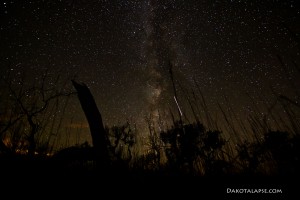
Bad Astronomer on the Meteor and persistent train
While shooting a Moon set with the Milky Way timelapse near the White River in South Dakota. I caught a meteor with a persistent train. It lasted for 68 frames of the timelapse then moved out of frame to the left. In real time it was over a half an hour. It takes a real bright meteor to show up this well in a frame. The timelapse looks real cool, that will be on my next video. Click the images to view full size. The first image was taken at 9:05 pm on October 1.
See a slowed down timelapse of this on Temporal Distortion
You can see the start of it on the left of the flash.

The Persistent train lasted over a half an hour, then moved to the left out of the frame. It is the orange cloud where the meteor was.
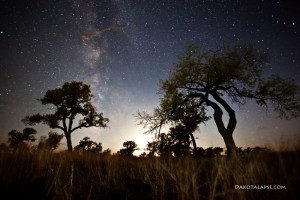

[add_to_cart item=”1007″ quantity=”user:1″ ]
[add_to_cart item=”1008″ quantity=”user:1″ ]
Tempest Milky Way won Best Overall and Audience Choice at the 2011 Chronos Film Festival
Download an extended cut of this video here, with almost 1 minute of extra footage. 5$ See stills below.
[nggallery id=8]
Order prints and gallery wraps on Zenfolio
Stills from footage on the extended cut.
One of the challenges in making this video, was trying to get good storm and star shots. The opportunity doesn’t come along very often, the storm has to be moving the right speed and the lightning can overexpose the long exposures. I had several opportunities this summer to get storm and star shots. With good . In one instance, within a minute of picking up the camera and dolly, 70mph winds hit. One storm was perfect, it came straight towards the setup, then died right before it reached it.
At the 1:57 mark a Whitetail buck came in to check out the setup. It was caught on 20 frames, and was there for about 10 minutes. It was only 50 yards from the camera, dolly and light.
At the 3:24 mark, a meteor reflects on the water of the small lake, see still below in Photos. There are also quite a few other meteors in the timelapse.
Canon 5D Mark II for a few shots, Canon 60D and T2i
Canon 16-35, Tokina 11-16
Exposure on most shots was 20-30 seconds, ISO 1600 or 3200 F2.8.
Simon Wilkinson at thebluemask.com created the music and sound for it.
Download the MP3 on his site http://www.thebluemask.com/shop/tempest/?tid=tempestmilkyway
Available in 4K Ultra HD for licensing.
Contact for licensing or anything else
Randy Halverson
dakotalapse@gmail.com
Follow:
Google + https://plus.google.com/115274420552571826637/posts
Facebook http://www.facebook.com/dakotalapse
Twitter http://www.twitter.com/dakotalapse
Still frames from Tempest Milky Way
[nggallery id=7]
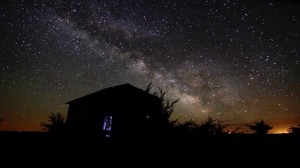
[add_to_cart item=”1003″ quantity=”user:1″ ]
[add_to_cart item=”1004″ quantity=”user:1″ ]
During the month of May, I shot Milky Way timelapse in central South Dakota when I had the time, and the weather cooperated. The biggest challenge was cloudy nights and the wind. There were very few nights, when I could shoot, that were perfectly clear, and often the wind was blowing 25mph +. That made it hard to get the shots I wanted. I kept most of the shots low to the ground, so the wind wouldn’t catch the setup and cause camera shake, or blow it over. I used a Stage Zero Dolly on the dolly shots and a “Milapse” mount on the panning ones.
This was all shot at night. If you see stars and it looks like daylight, it is actually moon light. 20+ second exposures make it look like daylight.
Canon EOS 60D and
Canon T2i
Tokina 11-16mm
Tamron AF 17-50mm
Dynamic Perception Stage Zero Dolly
Shot in RAW format, the Milky Way shots were 30 seconds exposure F2.8 or F1.8 with 2 second interval between shots, for 3-4 hours run time. ISO 1600, the opening shot was ISO 3200.
Ten seconds of the video is about 2 hours 20 minutes in real time.
Simon Wilkinson from thebluemask.com created the soundtrack “Exodus” for the video
Available in 4K Ultra HD for licensing.
“Orion” – motion controlled night timelapse from Randy Halverson on Vimeo.
Wired.com article Robo-Camera Rig Animates the Night Sky
Taken in central South Dakota in late march-early april. It was the first time I’ve had the chance to use an Orion head mounted on the Dynamic Perception Stage Zero dolly. dynamicperception.com
Orion head (aka Merlin or Celestron) telescope head allows for an ultra slow pan and tilt of the camera while it moves slowly along the dolly. The MX2 controller from Dynamic Perception also controls the Orion head. It wasn’t used on every shot, because it just wouldn’t work for it, or the shot was from the second camera mounted on a “milapse” telescope head. It works great with the MX2 controller from Dynamic Perception and I’ll be using it as often as I can. I tested the included controller with the Orion and found it was a little too fast for night timelapse, but with the MX2 controlling it, it worked great.
At 2:09 you can see Orion head panning and tilting on the dolly.
Canon EOS 60D and
Canon T2i
Tokina 11-16mm
Tamron AF 17-50mm
Shot in RAW format, most shots were 25 seconds exposure F2.8 with 2 second interval between shots, for about 300 frames or so (several hours). There were a few 30 second exposures. ISO 1600
Music is “Equinox” by American Dollar theamericandollar.info
For more info or licensing contact
dakotalapse.com
twitter.com/dakotalapse
facebook.com/pages/DakotaLapse/111818295557281
Sub Zero – winter night timelapse from Randy Halverson on Vimeo.
Shot in South Dakota in early February with most nights sub zero with -25 wind chill. Used Dynamic Perception Stage Zero dolly and Milapse mount on most of the shots.
The Dynamic Perception Stage Zero Dolly worked great in the sub zero temps.
Canon EOS 60D and
Canon T2i
Tokina 11-16mm
Tamron AF 17-50mm
Shot in RAW format most shots were 20 seconds exposure F2.8 with 1 second interval per shot for about 300 frames or so. There were a few 30 second and one 15 second exposures. ISO 1600
Music is “Scorpio” By Simon Wilkinson thebluemask.com
Simon’s Music has also been heard on Fox’s “24″
Read some articles about it in Media Coverage